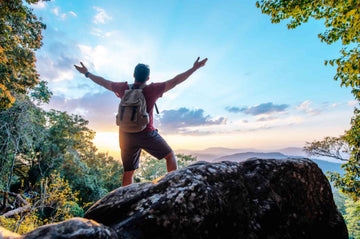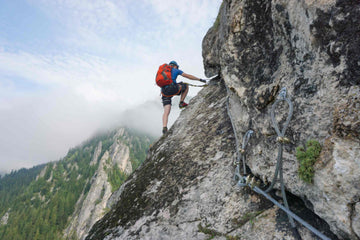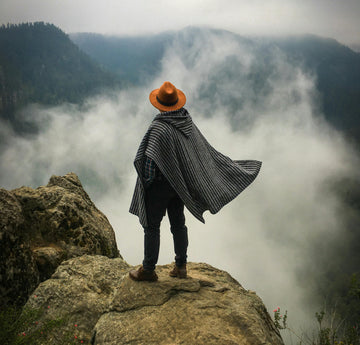The Guide to Hiking Essentials: Gear, Preparation, and Safety
by The Adventure Gears on Jun 26, 2024

Hiking is a wonderful way to explore the great outdoors, enjoy breathtaking landscapes, and stay fit. However, having the right gear and preparation is crucial for a safe and enjoyable hike. Whether you're a beginner or an experienced hiker, this comprehensive guide will help you understand the essential hiking items you need, how to prepare, and tips for staying safe on the trail.
Visit The Adventure Gears to explore a wide range of high-quality hiking gear and equipment designed to enhance your outdoor experience.
Why Hiking Essentials Matter
Hiking essentials are more than just a list of items; they are the foundation of a safe and successful hiking trip. Here's why having the right gear matters:
- Safety: Proper gear helps protect you from the elements and potential hazards.
- Comfort: The right equipment ensures you stay comfortable throughout your hike.
- Efficiency: Quality gear can make your hike more efficient and enjoyable.
- Preparedness: Being well-prepared can prevent emergencies and enhance your overall experience.
Essential Hiking Items
To ensure you have everything you need for a successful hike, here's a detailed list of essential hiking items:
- Navigation Tools: Maps, compasses, and GPS devices to help you stay on track.
- Hydration: Water bottles or hydration packs to keep you hydrated.
- Nutrition: High-energy snacks and meals to fuel your body.
- Clothing: Appropriate clothing for the weather, including moisture-wicking layers, rain gear, and extra socks.
- Footwear: Sturdy hiking boots or shoes that provide support and protection.
- Shelter: Lightweight tents or emergency shelters for overnight hikes.
- First Aid Kit: A comprehensive first aid kit to handle minor injuries.
- Lighting: Headlamps or flashlights with extra batteries.
- Tools and Repair Kits: Multi-tools, duct tape, and repair kits for gear maintenance.
- Fire Starters: Matches, lighters, or fire starters for emergencies.
- Sun Protection: Sunglasses, sunscreen, and hats to protect from UV rays.
- Insect Repellent: To keep bugs and ticks at bay.
Explore our Hiking Gear Essentials for high-quality gear that meets all your hiking needs.
Detailed Look at Hiking Gear Essentials
Navigation Tools
Navigation is key to a successful hike. Here’s what you need:
- Maps: Always carry a detailed map of the area.
- Compass: A reliable compass for orientation.
- GPS Device: A handheld GPS for precise navigation.
- Mobile Apps: Download hiking apps for additional support.
Hydration
Staying hydrated is crucial. Here are some options:
- Water Bottles: Durable and easy to carry.
- Hydration Packs: Convenient for hands-free hydration.
- Water Filters: For purifying water from natural sources.
Nutrition
Proper nutrition keeps your energy levels up. Consider these:
- High-Energy Snacks: Nuts, dried fruits, and energy bars.
- Meals: Lightweight, easy-to-prepare meals for longer hikes.
- Electrolytes: Supplements to replenish lost minerals.
Visit our Nutrition Section for a variety of hiking snacks and meals.
Clothing for Hiking
Choosing the right clothing is essential for comfort and safety. Here are some tips:
- Layering: Use a layering system to regulate body temperature.
- Moisture-Wicking: Choose fabrics that wick moisture away from your skin.
- Insulation: Pack insulating layers for warmth.
- Rain Gear: Waterproof jackets and pants to stay dry.
- Footwear: Invest in high-quality hiking boots or shoes.
Check out our Winter Warm Underwear for comfortable and warm hiking clothing.
Footwear for Hiking
The right footwear can make a huge difference. Here’s what to look for:
- Hiking Boots: Provide ankle support and protection.
- Hiking Shoes: Lightweight and comfortable for shorter hikes.
- Trail Runners: Suitable for fast-paced hikes on well-maintained trails.
Shelter and Sleeping Gear
For overnight hikes, having the right shelter is crucial. Here are some options:
- Tents: Lightweight and easy to set up.
- Emergency Shelters: Compact and essential for emergencies.
- Sleeping Bags: Choose one appropriate for the season and temperature.
Explore our Tents and Shelters for reliable and high-quality options.
First Aid Kit
A well-stocked first aid kit is essential. Include these items:
- Bandages and Dressings: For cuts and wounds.
- Medications: Pain relievers, antihistamines, and personal medications.
- Tools: Tweezers, scissors, and safety pins.
- Emergency Supplies: Whistle, emergency blanket, and CPR mask.
Check out our First Aid Kits for comprehensive kits tailored for hiking.
Lighting
Good lighting is essential for safety. Here’s what to pack:
- Headlamps: Hands-free and adjustable.
- Flashlights: Durable and bright.
- Extra Batteries: Always carry spares.
Tools and Repair Kits
Being able to fix gear on the trail is crucial. Here’s what you need:
- Multi-Tools: Versatile tools for various repairs.
- Duct Tape: For quick fixes.
- Repair Kits: For tents, sleeping bags, and clothing.
Explore our Multi-Tools for reliable and compact options.
Fire Starters
Being able to start a fire is essential for warmth and cooking. Here are some options:
- Matches: Waterproof and easy to use.
- Lighters: Reliable and refillable.
- Fire Starters: Easy to ignite in all conditions.
Visit our Fire Starters for high-quality fire-starting tools.
Sun Protection
Protecting yourself from the sun is crucial. Here’s what you need:
- Sunglasses: UV-protective lenses.
- Sunscreen: Broad-spectrum SPF.
- Hats: Wide-brimmed hats for shade.
Insect Repellent
Keeping insects at bay is essential for a comfortable hike. Here are some options:
- Sprays: Effective against mosquitoes and ticks.
- Wipes: Easy to apply and carry.
- Clothing Treatments: Long-lasting protection for your gear.
Internal Links to Explore More
For more information on our products and to explore our extensive range of hiking gear, check out these links:
- Solar Camping Shower Bag: Perfect for maintaining hygiene on long hikes.
- First Aid Kit: Essential for handling emergencies on the trail.
- 40L Hiking Backpack: Spacious and durable for carrying all your essentials.
- Multi-Tool: Versatile and compact for various repairs and tasks.
- Winter Warm Underwear: Stay warm and comfortable on your hike.
Preparing for a Hike
Preparation is key to a successful hike. Here’s how to get ready:
- Research the Trail: Understand the difficulty level, length, and conditions of the trail. 2. Check the Weather: Always check the weather forecast and be prepared for changes.
- Inform Others: Let someone know your hiking plans, including your route and expected return time.
- Pack Smart: Organize your gear efficiently and only carry what you need.
- Train Physically: Ensure you are in good physical condition to handle the hike.
Packing List for a Day Hike
Creating a detailed packing list can ensure you don’t forget any essentials. Here’s a suggested list for a day hike:
- Backpack: A comfortable, well-fitting backpack.
- Water: At least 2 liters, more in hot weather.
- Food: High-energy snacks and a light meal.
- Clothing: Weather-appropriate layers, extra socks, and rain gear.
- First Aid Kit: Basic supplies for minor injuries.
- Navigation: Map, compass, and GPS device.
- Tools: Multi-tool and duct tape.
- Fire Starters: Matches or lighter.
- Lighting: Headlamp or flashlight with extra batteries.
- Sun Protection: Sunglasses, sunscreen, and hat.
- Insect Repellent: Spray or wipes.
- Shelter: Emergency blanket or bivy sack.
Multi-Day Hike Essentials
For longer hikes, you’ll need additional gear. Here’s what to pack for a multi-day hike:
- Tent: Lightweight and weather-resistant.
- Sleeping Bag: Appropriate for the season.
- Sleeping Pad: For insulation and comfort.
- Cooking Gear: Stove, fuel, pot, and utensils.
- Food: Dehydrated meals, snacks, and extra food for emergencies.
- Water Filtration: Filters or purification tablets.
- Extra Clothing: Additional layers and socks.
- Repair Kits: For tents, sleeping bags, and clothing.
- Extra Batteries: For headlamps and other electronics.
- Bear Canister: If hiking in bear country.
Safety Tips for Hiking
Safety should always be a priority. Here are some essential safety tips:
- Stay on Marked Trails: Avoid getting lost by sticking to marked paths.
- Know Your Limits: Don’t push yourself beyond your physical capabilities.
- Stay Hydrated: Drink water regularly, even if you don’t feel thirsty.
- Pace Yourself: Take breaks and rest when needed.
- Be Aware of Wildlife: Know how to handle encounters with wildlife.
- Carry a First Aid Kit: Be prepared to handle minor injuries.
- Check the Weather: Be aware of weather changes and seek shelter if necessary.
- Travel in Groups: If possible, hike with others for safety.
Leave No Trace Principles
Following the Leave No Trace principles helps protect the environment and ensures trails remain enjoyable for everyone. Here are the seven principles:
- Plan Ahead and Prepare: Know the regulations and special concerns for the area you’ll visit.
- Travel and Camp on Durable Surfaces: Stick to established trails and campsites.
- Dispose of Waste Properly: Pack out all trash, leftover food, and litter.
- Leave What You Find: Preserve the past and leave rocks, plants, and other natural objects as you find them.
- Minimize Campfire Impact: Use a lightweight stove for cooking and enjoy a candle lantern for light.
- Respect Wildlife: Observe wildlife from a distance and do not follow or approach them.
- Be Considerate of Other Visitors: Respect other visitors and protect the quality of their experience.
Hiking with Kids
Hiking with kids can be a rewarding experience. Here are some tips for making it enjoyable:
- Choose Easy Trails: Start with short, easy hikes that match your child’s abilities.
- Pack Snacks: Bring plenty of snacks to keep their energy levels up.
- Take Breaks: Plan for frequent breaks to rest and explore.
- Engage Them: Teach them about nature and involve them in planning.
- Safety First: Keep them within sight and ensure they know basic safety rules.
Hiking with Pets
Bringing your pet along on a hike can be fun. Here’s how to prepare:
- Check Trail Rules: Ensure pets are allowed on the trail.
- Pack for Your Pet: Bring water, food, and a bowl for your pet.
- Leash and Control: Keep your pet on a leash and under control at all times.
- Watch for Hazards: Be aware of wildlife and plants that could be harmful.
- Pet First Aid: Carry a pet first aid kit and know basic first aid for pets.
Environmental Considerations
Being mindful of the environment is crucial when hiking. Here are some ways to minimize your impact:
- Stay on Trails: Prevent erosion and protect vegetation by staying on designated trails.
- Pack Out Trash: Carry all waste with you, including biodegradable items.
- Use Biodegradable Products: Choose biodegradable soaps and toiletries.
- Respect Wildlife: Keep a safe distance and do not disturb animals.
- Conserve Water: Use water sources sparingly and avoid contaminating them.
Advanced Hiking Techniques
For more experienced hikers, here are some advanced techniques to enhance your hiking experience:
- Off-Trail Navigation: Learn how to navigate using a map and compass without relying on marked trails.
- Foraging: Understand which plants and berries are safe to eat.
- Water Sourcing: Know how to find and purify natural water sources.
- Advanced First Aid: Take a wilderness first aid course to handle more serious injuries.
- Survival Skills: Learn essential survival skills such as building a shelter and starting a fire without matches.
Enhancing Your Hiking Experience
Making your hike more enjoyable can be as simple as bringing along some extra items or trying new techniques:
- Photography: Bring a camera to capture the beauty of your hike.
- Bird Watching: Carry a guidebook and binoculars for bird watching.
- Journaling: Keep a journal to document your thoughts and experiences.
- Stargazing: If hiking overnight, bring a star map to enjoy the night sky.
- Nature Identification: Use apps or guides to identify plants, animals, and geological features.
Exploring Different Types of Hikes
There are various types of hikes you can explore, each offering unique experiences:
- Day Hikes: Short hikes that can be completed in a single day.
- Backpacking: Multi-day hikes that involve camping overnight.
- Thru-Hiking: Long-distance hiking that covers an entire trail from end to end.
- Section Hiking: Hiking sections of a long-distance trail over time.
- Summit Hikes: Climbing to the peak of a mountain.
Internal Links to Explore More
For more information on our products and to explore our extensive range of hiking gear, check out these links:
- Solar Camping Shower Bag: Perfect for maintaining hygiene on long hikes.
- First Aid Kit: Essential for handling emergencies on the trail.
- 40L Hiking Backpack: Spacious and durable for carrying all your essentials.
- Multi-Tool: Versatile and compact for various repairs and tasks.
- Winter Warm Underwear: Stay warm and comfortable on your hike.
Conclusion
Hiking is a fantastic way to explore nature, stay fit, and enjoy the great outdoors. By being well-prepared with the essential hiking items and following the tips outlined in this guide, you can ensure a safe, enjoyable, and memorable hiking experience. Remember to respect the environment, stay safe, and have fun exploring the trails.
For more insights and to explore our range of hiking gear and equipment, visit The Adventure Gears.
Don’t forget to check out our Solar Camping Shower Bag, First Aid Kits, and 40L Hiking Backpack for specialized benefits.




